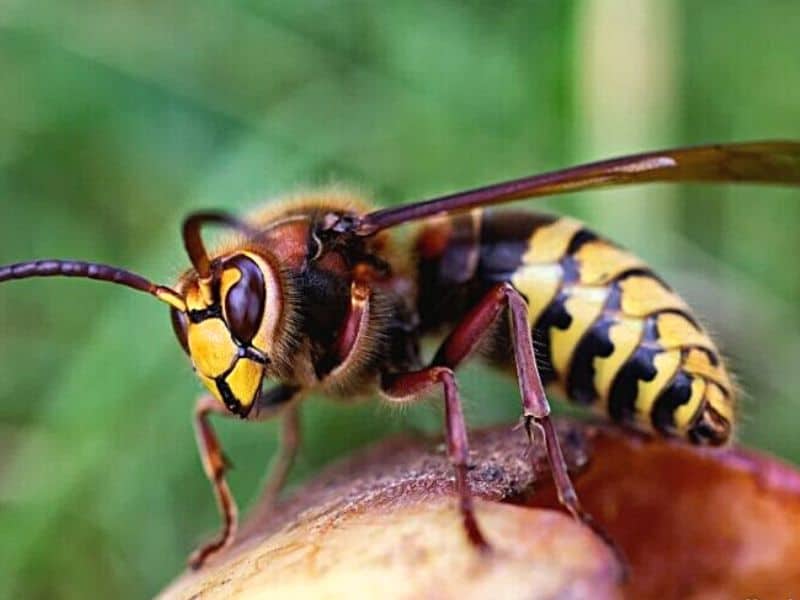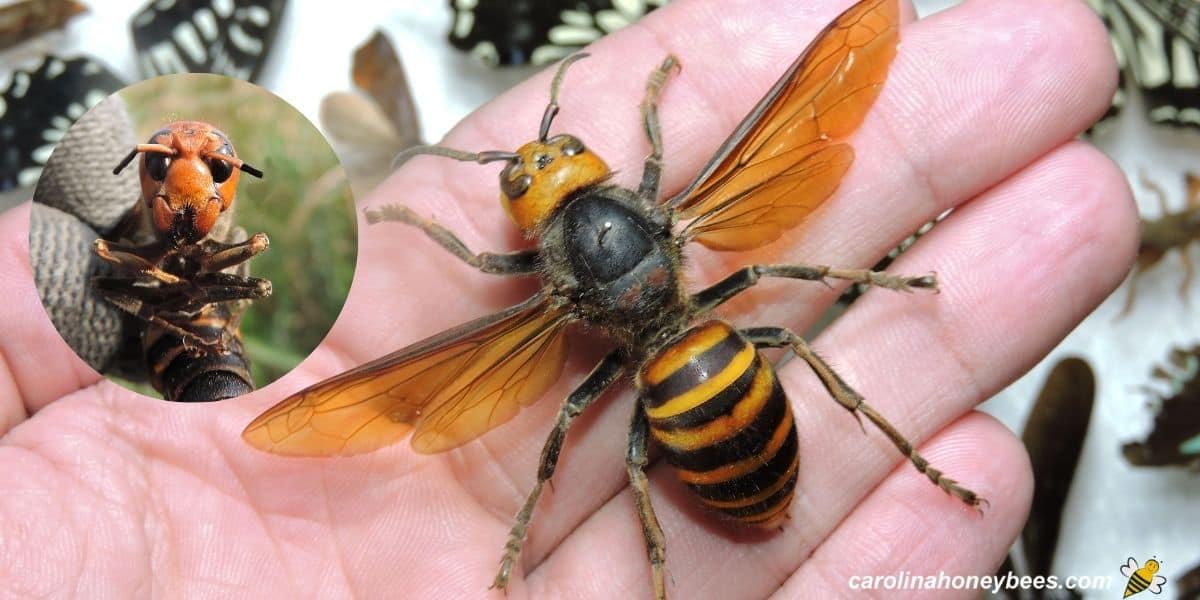Hornets and Bees
The discovery of a new type of hornet in the United States caused a bit of concern to the beekeeping industry in recent years. Being insect predators, hornets do eat bees. So, why the big fuss over this new insect? They have been given the name “Killer Hornet” by the media. Should beekeepers be worried about this newest predator-or any hornet?

Many insects prey on each other. This is all about the balance of life. But sometimes, it seems that things get out of balance when a new insect enters a local ecosystem. And some of these become predators of honey bee colonies.
Hornets Prey On Bee Colonies
It seems that our honey bees are under attack from one direction or another constantly. The over-use of pesticides and herbicides contaminate foods that bees eat and water sources.
Pests that are new to an area (Varroa Mites) move in devastating thousands of bee colonies each year.
And in recent history – we have a new insect predator in the United States – the Giant Asian Hornet (Vespa mandarinia).
At present, they have only been found in a few locations in the US. If you find a hornet (or a nest) in your backyard, chances are you are not facing this new variety.
But, that does not mean your bee colonies are safe from hornets. There are many insect predators that consume honey bees. And, having some bee loss due to hornets is nothing new.
Hornets catch and consume bees and other insects for a source of protein. Yes, they may take a sip of sweet nectar but they are hunters not gatherers.

The Bald-Faced Hornet is Not a Hornet
As an interesting aside, I must mention the bald-faced hornet. The term “bald” means white. They are a popular sight in my region and do a good job of catching flies.
Warned about them since childhood, I know enough to give them the respect they require. While they can and do kill bees, they do not seem to focus on honey bees like the others.
The funniest thing about them is that they are not true hornets. Scientifically, they are considered wasps not members of the hornet family. They do have a serious attitude – give any wasp nests a wide berth.
Asian Giant Hornets – Killer Hornet
The new arrival that caused so much media excitement is native to east Asia and Japan. The Giant Asian Hornet (Vespa mandarinia) can reach a length up to 2 “long.
It has a distinctive yellow and orange head. They live in colonies in the ground or the trunks of dead trees and can fly up to 25 mph.
A beekeeper’s suit is no protection from the long stinger and powerful venom of these predatory hornets.
A human receiving multiple stings could die even if they are not allergic to the venom. In Japan, an average of 50 people are killed by these hornet attacks each year.
Asian Hornets vs European Hornets
Now that I have your attention, lets consider the hornets that you are likely to encounter near your beehives. I am talking about the European Hornet (Vespo crabo).
First found in the United States around 1840, these insects have spread across most of the country. They are mistakenly called “Japanese Hornets” or brown hornets but their true name is European Hornets.
They are large yellow and brown insects and were previously the only true hornets in the United States. Though both types of hornets kill honey bees – there are some notable differences.

European Hornet (Vespo crabo)
- mistakenly called Japanese Hornet
- previously only true hornet in US
- mostly yellow abdomen with rows of black teardrops -yellow and brown coloration head
- normally nest inside cavities
- predator of other insects – yes they eat bees
- sometimes forage at night
- often attracted to outside lights at night
- not generally aggressive away from nest

Asian Giant Hornet (Vespa mandarinia)
- also called Killer Hornet or Murder Hornet
- native to eastern Asia
- striking yellow head- banded yellow and brown on abdomen
- typically nest in the ground or in tree cavities close to ground
- predator of other insects – yes they eat bees
- do not forage at night
How Hornets Attack Beehives
Both types of hornets prey on honey bees and other insect pollinators. In truth, a large nest of European Hornets nearby can cause a serious problems for any beekeeper.
Some beekeepers have experienced severe depopulation of their hives by European Hornet attack. These predators catch bees returning to the hive or worker bees collecting resources for the colony.
It is not uncommon for a beekeeper to use a purchased or homemade yellow jacket trap to catch some hornets near the apiary. But, this only makes a dent in a strong population.

When a single hornet enters a bee hive, the bees are not without recourse.Hundreds of bees will “ball” the intruder (just like a queen) and kill it.
However, many hornets attacking a colony at the same time can devastate the hive. Hornets attack and kill adults, bee larvae and pupae. In large numbers, they can decimate a bee colony in a matter of hours.
The most likely time to experience problems from hornet attacks on beehives will be in late Summer to Fall. During this time the hornet colony is at peak population.
Hornets prey on bees by catching them in the air or attacking when the bee is on a flower or other food source.
I have watched them catch a bee and fly to a nearby tree to tear the bees head off. Nasty buggers from my perspective.
Why Asian Hornets are a Particular Threat
In addition to their large size, the newly arrived Asian Giant Hornet has other characteristics that make it a particular threat to honey bees.
For reasons not understood, in late Summer the Asian Giant Hornet tends to seek out honey bee hives in particular. In this time, other types of prey are less attractive to them.
In areas where giant hornets have been a problem, beekeepers have experienced piles of dead bees in front of the hives.
This is a similar scenario to a pesticide bee kill. When foraging bees come into contact with lethal pesticides it is common to see piles of dead bees in front of the hive.
However, after an Asian Hornet attack, piles of dead bees at the hive entrance are missing their heads. The predator tears off the head of the prey. The rest of the body is carried back to their nest to feed young.
Should Beekeepers Worry About Murder Hornets?
If you are a beekeeper worried about your colonies, what should you do? Don’t panic. Listen for news of more sightings -especially in areas that are near you.
The Murder Hornet was first spotted in the US in late 2019 in Washington state. Only 2 were confirmed at that time.
Since then, researchers and beekeepers across the country have been on the hunt for more sightings. There have only been a handful of confirmed Giant Asian Hornets found.
If you suspect a nest of giant murder hornets on your property, call your local extension agents. This is not a job for amateurs.
Most of the reported sightings are by people who are getting them confused with the more common European hornet.
The best defense against any insect attack on your hives is to keep strong colonies. Also, if you notice a problem from hornets, yellow jackets or similar – reduce the hive entrance – making it easier for the bees to defend themselves.
Other Threats
You can’t kill every hornet and we would not want to – they serve a purpose in the ecosystem. Loss of a few bees is not the end of the world. In fact, some birds eat bees too but birds are rarely a problem for healthy hives.
In the mean time, keep an eye out for nests of European hornets near your bee yards. If you can do so safely, it is good to destroy their nests when close to your home or beehives.
Our bees and beekeepers do not need more problems. However in truth, queen failures, lack of properly times varroa mite control and other beehive management issues are a much bigger threat to most of our hives.
FAQs
Hornets may be scary and carry a painful stinger but they are important to the ecosystem in several ways. They help control the population of caterpillars, spiders and other insect pests that destroy crops.
No, hornets do not make honey. With a different social structure than honey bees, the whole colony does not over-winter – only the mated females. There is no need to store food for the cold months.
Yes, a hornet colony does have a queen. But unlike honey bees, she helps take care of young – especially in the early season when she builds her own nest.
They have a strong stinger with powerful venom. Anyone who is stung by a hornet will remember it for a while.
In general, they do not live in the ground. They build large grey paper nests or build paper nests inside tree cavities.
A Final Word
Call it whatever you want: Asian, Killer or Murder Hornet – it is certainly not good news for anyone. Like other hornets, the stings are painful and care should be taken to stay away from the nest. No one knows if this hornet will become well established in the US.
It is always good to educate yourself and understand the role played bees vs wasps, hornets and other insects that interact with our beehives. We must remember that other insects are important to our local ecosystem.

